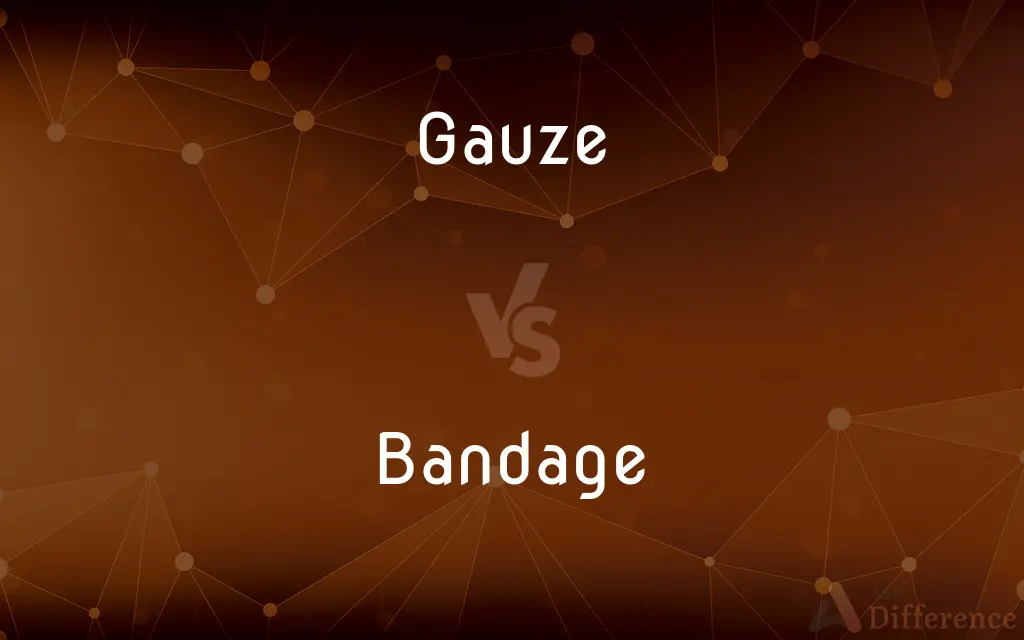Gauze vs. Bandage — What's the Difference?
By Urooj Arif & Maham Liaqat — Updated on April 3, 2024
Gauze is a thin, woven fabric used for wound dressing, while a bandage is any material used to support or secure dressings.

Difference Between Gauze and Bandage
Table of Contents
ADVERTISEMENT
Key Differences
Gauze is a lightweight, porous fabric typically made from cotton and used in medical settings for dressing wounds, absorbing fluids, and protecting injury sites from infection. Bandages, on the other hand, are materials used to support or secure dressings on a wound, provide compression to control bleeding, support injured limbs or joints, and reduce swelling.
Gauze and bandages are often used together in wound care: gauze is applied directly to the wound to dress and protect it, and a bandage is then wrapped over the gauze to keep the dressing secure and in place. This combination allows for effective wound management, providing both protection and support. While gauze primarily deals with the immediate treatment of the wound, bandages serve a broader range of purposes, including securing the wound dressing, providing compression, and supporting injured body parts.
The selection between gauze and bandages, or the decision to use both, depends on the nature and severity of the injury. Gauze is indispensable for its ability to dress wounds and promote healing, while bandages are essential for their ability to secure these dressings, reduce movement, and provide support. Healthcare professionals choose the appropriate type and combination of these materials based on the specific requirements of each wound or injury.
While both gauze and bandages play crucial roles in wound care and management, their functions, applications, and materials differ significantly. Gauze is specialized for wound dressing and absorption, whereas bandages are versatile tools for securing dressings, providing support, and compressing injuries.
Comparison Chart
Material
Thin, woven cotton fabric
Various (cloth, elastic, self-adhesive)
ADVERTISEMENT
Primary Use
Dressing wounds, absorbing fluids
Securing dressings, supporting limbs
Application
Directly on wounds
Over dressings or around injured areas
Functionality
Allows air flow, protects against infection
Provides compression, support, secures dressing
Forms
Rolls, pads, sponges
Cloth strips, elastic wraps, self-adhesive bandages
Sterility
Can be sterile or non-sterile
Typically non-sterile, but sterile versions exist
Compare with Definitions
Gauze
Can be used as packing material.
Gauze was packed into the wound to help absorb excess fluid.
Bandage
Material for securing dressings.
An elastic bandage was wrapped around the sprained ankle for support.
Gauze
Absorbs fluids, allows air flow.
Gauze pads were placed on the burn to absorb the ointment and let the skin breathe.
Bandage
Provides compression and support.
The bandage was applied tightly to control bleeding.
Gauze
Porous fabric for wound dressing.
The nurse used sterile gauze to cover the scraped knee.
Bandage
Used for a variety of injuries.
Cloth bandages were used to hold splints in place on a broken arm.
Gauze
Comes in sterile and non-sterile forms.
Non-sterile gauze was used for minor, superficial cuts.
Bandage
Can be elastic or self-adhesive.
A self-adhesive bandage was used for its convenience and ease of application.
Gauze
Essential for infection prevention.
Sterile gauze was applied to the surgical incision to prevent infection.
Bandage
Helps reduce swelling and movement.
Compression bandages were used to minimize swelling after surgery.
Gauze
Gauze is a thin, translucent fabric with a loose open weave. In technical terms "gauze" is a weave structure in which the weft yarns are arranged in pairs and are crossed before and after each warp yarn keeping the weft firmly in place.
Bandage
A bandage is a piece of material used either to support a medical device such as a dressing or splint, or on its own to provide support to or to restrict the movement of a part of the body. When used with a dressing, the dressing is applied directly on a wound, and a bandage used to hold the dressing in place.
Gauze
A thin, transparent fabric with a loose open weave, used for curtains and clothing.
Bandage
A strip of woven material used to bind up a wound or to protect an injured part of the body
A strip of bandage
Her leg was swathed in bandages
Gauze
A thin, loosely woven surgical dressing, usually made of cotton.
Bandage
Bind (a wound or a part of the body) with a protective strip of material
Bandage the foot so that the ankle is supported
Gauze
A thin plastic or metal woven mesh.
Bandage
A strip of material such as gauze used to protect, immobilize, compress, or support a wound or injured body part.
Gauze
A mist or haze.
Bandage
To apply a bandage to.
Gauze
A thin fabric with a loose, open weave.
Bandage
A strip of gauze or similar material used to protect or support a wound or injury.
Gauze
(medicine) A similar bleached cotton fabric used as a surgical dressing.
Bandage
A strip of cloth bound round the head and eyes as a blindfold.
Gauze
A thin woven metal or plastic mesh.
Bandage
A provisional or makeshift solution that provides insufficient coverage or relief.
This new healthcare proposal merely applies a bandage to the current medical crisis
Gauze
Wire gauze, used as fence.
Bandage
To apply a bandage to something.
Gauze
Mist or haze
Bandage
A fillet or strip of woven material, used in dressing and binding up wounds, etc.
Gauze
To apply a dressing of gauze
Bandage
Something resembling a bandage; that which is bound over or round something to cover, strengthen, or compress it; a ligature.
Zeal too had a place among the rest, with a bandage over her eyes.
Gauze
(literary) To mist; to become gauze-like.
Bandage
To bind, dress, or cover, with a bandage; as, to bandage the eyes.
Gauze
A very thin, slight, transparent stuff, generally of silk; also, any fabric resembling silk gauze; as, wire gauze; cotton gauze.
Bandage
A piece of soft material that covers and protects an injured part of the body
Gauze
Having the qualities of gauze; thin; light; as, gauze merino underclothing.
Bandage
Wrap around with something so as to cover or enclose
Gauze
(medicine) bleached cotton cloth of plain weave used for bandages and dressings
Bandage
Dress by covering or binding;
The nurse bandaged a sprained ankle
Bandage an incision
Gauze
A net of transparent fabric with a loose open weave
Common Curiosities
How do bandages help in injury recovery?
Bandages support and secure dressings, provide compression to control bleeding, and support injured limbs or joints to aid recovery.
Can gauze be used without a bandage?
Yes, gauze can be used alone for minor wounds that don't require additional support or compression from a bandage.
How do you choose between sterile and non-sterile gauze?
Sterile gauze is used for open wounds or surgical applications to prevent infection, while non-sterile gauze may be used for minor cuts or as secondary dressing.
Can bandages be reused?
Cloth bandages can be washed and reused, but elastic and self-adhesive bandages are generally designed for single use, especially when used directly on wounds.
How do self-adhesive bandages compare to traditional bandages?
Self-adhesive bandages offer convenience and ease of application without the need for clips or pins and are often used for securing dressings or providing light support.
What types of bandages are there?
There are cloth bandages, elastic bandages, and self-adhesive bandages, each designed for specific uses.
Are all bandages elastic?
No, not all bandages are elastic. Some are made from non-elastic cloth material, while others are elastic or self-adhesive for different levels of support and application needs.
What is the significance of air flow in wound healing?
Air flow helps to keep the wound dry and promotes the natural healing process, which is why breathable materials like gauze are preferred for dressing wounds.
What is the main purpose of gauze in wound care?
Gauze is primarily used for dressing wounds, absorbing fluids, and preventing infection.
Is it better to wrap a sprained ankle with an elastic bandage or gauze?
An elastic bandage is preferred for a sprained ankle for its ability to provide compression and support, which are essential for healing and stabilization.
How often should gauze be changed on a wound?
The frequency depends on the wound's condition and the doctor's advice, but it's typically changed daily or whenever it becomes wet or dirty.
Share Your Discovery

Previous Comparison
Forum vs. Platform
Next Comparison
Scorpion vs. AntAuthor Spotlight
Written by
Urooj ArifUrooj is a skilled content writer at Ask Difference, known for her exceptional ability to simplify complex topics into engaging and informative content. With a passion for research and a flair for clear, concise writing, she consistently delivers articles that resonate with our diverse audience.
Co-written by
Maham Liaqat













































